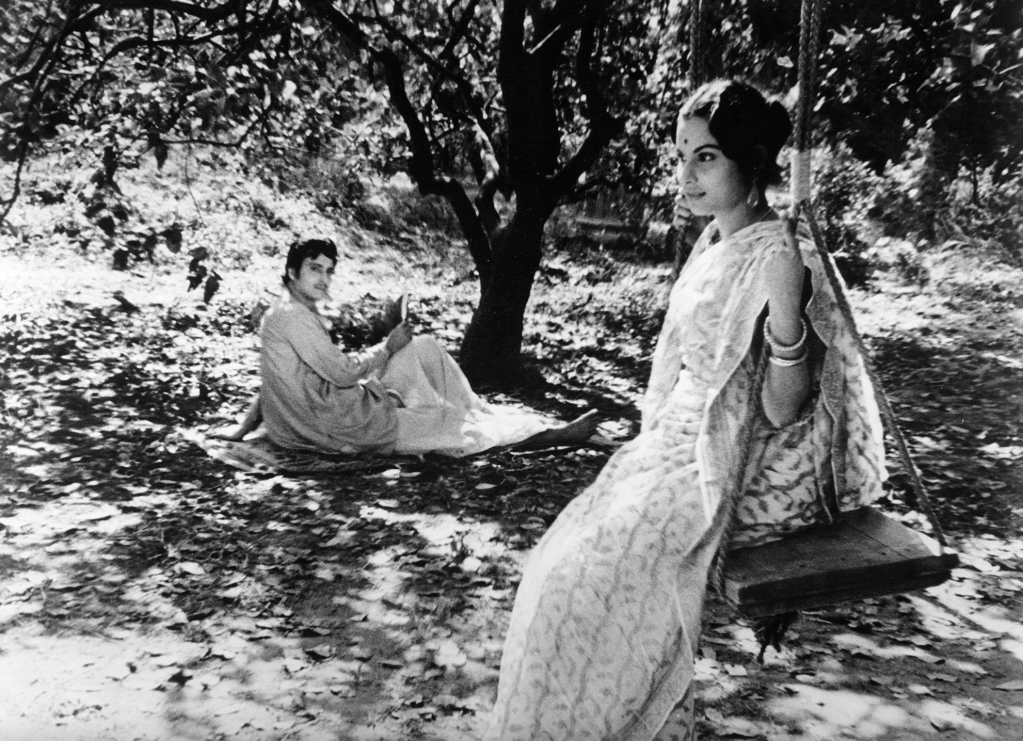Charulata (1964), Satyajit Ray’s 12th film (and the one many contend, including Ray, is his best), opens with an unforgettable display of loneliness. We’re in the middle of a typical day in the life of the title character (Madhabi Mukherjee), which, at this point in her marriage to newspaper publisher Bhupati (Sailen Mukherjee), mostly all blend together, barely indistinguishable from the last. The housewife makes some good progress on an embroidering project and does some reading, but the ways she keeps herself occupied do little to make more bearable the stifling silence she’s met with every day in her bird cage of a mansion. Her miserable aloneness is thrown back at her by the life she can see and hear just outside the windows. One of this day’s most colorful passersby is a street musician kept company by a couple of leashed-up pet monkeys, their wandering bestowed unknowing significance by the frames of Charulata’s gold binoculars.
So preoccupied with his editing and writing, Bhupati hasn’t noticed the extent of Charulata’s isolation until she gifts him a craft, offhandedly quipping about the free time and the loneliness that’s helped her to finish so quickly. Far more attentive than most husbands circa 1880 (the film takes place during the Bengali Renaissance, in Kolkata), Bhupati invites Charulata’s brother, Umapada (Shyamal Ghoshal), and his wife, Manda (Gitali Roy), to live with them. Umapada can help manage the paper; Manda can keep Charulata company during the day. The gesture, though, quickly proves ill-fitting, not just because Umapada — though Bhupati won’t realize this before it’s too late — doesn’t have the business savvy to keep a paper afloat, but also because the most the shallow Manda can do to engage Charulata is simple card games. Charulata, Bhupati doesn’t realize, has absorbed some literary passion through all her reading; she has a yen for writing waiting to be tapped. The written word gives Charulata the sense of autonomy she cannot so readily practice in a life where she must abide by the era’s domestic mores.
When Bhupati’s younger cousin, Amal (Soumitra Chatterjee), comes to visit, hoping only to write and relax, the timing feels just right. He, like Charulata, is taken with fiction and poetry, starkly contrasting with a husband whose interest in writing begins and ends with its relationship with politics and the issues du jour. Bhupati picks up on this and encourages his cousin to help nurture Charulata’s interests. Closer in age to Charulata (he’s 23 and fresh out of college), Amal and Charulata develop a fast friendship that also, Ray suggests, is some cause for alarm. Amal’s sudden arrival is marked by a violent thunderstorm. In a later scene, where the pair spend a leisurely afternoon out in the sun, the camera homes in on Charulata’s blissed-out face while she flies on a swing set, absent-mindedly singing while her eyes alternately appreciate her surroundings and the sleeping face of a napping cousin-in-law for whom she’s developing feelings she most likely can’t yet pinpoint.

Madhabi Mukherjee in Charulata.
Our inclination, as the movie goes on, is to anticipate a fully fledged affair between Amal and Charulata, the devastations on the latter and Bhupati’s marriage because of it inevitable. But the movie more obliquely creates a romance between Amal and Charulata nearly exclusively through gestures — Amal singing to Charulata in one scene and her tugging on his arm, crying, and begging him not to leave when he threatens to in another — that make clear that even if the feelings neither would outwardly name have been acted on, they’re there, their presence alone enough to be destructive if to in any way be noticed. The film visually darkens the stronger the possibility becomes.
One man in Charulata’s life represents constraint, the other freedom, though Ray, adapting the novella Nastanirh by Rabindranath Tagore, does not particularly villainize or heroize one over the other. Bhupati recognizes his failings as a husband and tries to remedy them, though the use of other people as a way to mitigate what he cannot himself accomplish with the laser focus with which he approaches his work can only go so far. It’s heartening, though, to see how serious he is about Charulata’s creative talents, which comes to a head late-film when she proposes a professional partnership — he focus on the political side of the paper, she the more artistic — and he is immediately eager to dive in; it’s conversely disheartening how much he tries to discourage Amal from the career he wants, thinking it better a man go into something serious, like law, than wax rhapsodic about life’s beauties in writing. Amal eventually can tell what he really means to Charulata — something he internally reciprocates — but he refuses to make them external, deciding that it is ultimately not worth it for his happiness to come at the cost of another’s.
Ray’s preference for emotional realism — for framing his three leads’ hopes and dreams as worthwhile — over the temptations of melodramatic plotting makes Charulata more devastating than it would have been had it given into the lure of a soap-operatic approach. Its characters feel more real, lived-in. Ray has famously said that if he were to make one of his movies a second time, he would make Charulata the exact same way. Watching Charulata, you wouldn’t want it any differently.
